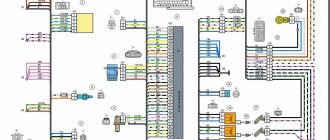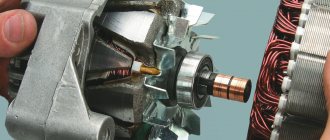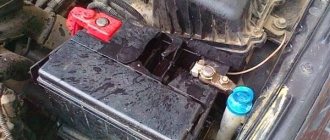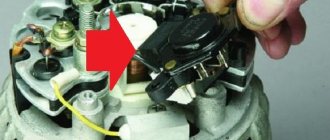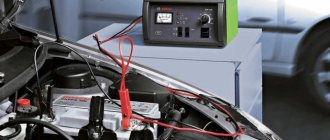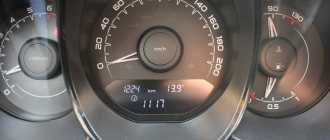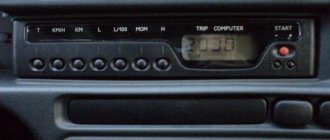Problems with the power supply in a car are major troubles for the car owner. And if these problems began to occur suddenly and in the most unpleasant conditions, you need to know the main reasons for such a problem. Most often, the problem of low voltage in the on-board network is not fatal, but it has its unpleasant consequences. So you should always draw conclusions in a timely manner and reduce the risk of final equipment failure. Poor operation of the main electrical network devices creates many malfunctions and problems. It is very important not to continue using the car with such problems, otherwise you may be left without a car altogether. It is worth recognizing that the danger lies not only in poorly lit light bulbs, but also in a possible short circuit, in a variety of problems and malfunctions of any part of the car.
In a modern car, literally everything depends on electricity, so a poor power supply will be an extremely dangerous factor. It is important to consider that all functions of the machine are connected to electricity. Previously, this resource was needed for launch, and even then it was not necessary. It was possible to start the car from a pusher. Today, without power, it is impossible to turn the steering wheel, open the stack, or even open the car itself. So let's take a closer look at how to diagnose low voltage in the on-board network, determine its cause, and also cope with all sorts of problems in this industry. If you have ever encountered such problems, be sure to describe your case in the comments. Each car may have its own individual problems, but we will consider only the most common problems with your vehicle.
How to identify electrical problems in a car?
The first step is to understand whether your car really has power problems. There are two groups of problems in this regard; roughly, all problems can be divided into problems during startup and strange operation of the electrical network after starting the engine. It is important to distinguish this because different modules are involved in these processes. It’s worth figuring out what symptoms of the car you should look for if the electrical network is not working well after starting the engine:
- the operation of all the lamps in the cabin, as well as the headlights, side lights and brake lights is too dim; this may not be very noticeable, but in reality the difference in brightness is noticeable;
- turning off some elements of the electrical network without permission under fairly heavy loads, for example, when the fan in the cabin is turned on, the music may turn off;
- when revving up at idle, the brightness of the interior lighting noticeably increases for a second, but when other equipment is turned on, the brightness decreases;
- perhaps a barely noticeable or annoying blinking of the light, uneven illumination of the road, rapid failure of light bulbs in various modules of your car;
- a decrease in fan speed is noticeably felt when optics, music or other power consumers are turned on; there may be an incorrect connection in the network.
The problem is that a car owner can easily get used to many such manifestations. And in this case there will be no surprises. You can get used to dim light, poor airflow and other troubles. But in general, this mode of operation is very harmful to your car. Sudden failure of the fuel pump, climate system, poor operation of the automatic transmission and other components is possible.
A little theory
First you need to understand what functions the battery performs:
- Starts the engine. Namely, it provides energy (spark) for ignition and rotates the starter motor. Well, and, of course, in modern car models it provides power to all electronics. If the battery is completely discharged or absent, the engine cannot be started at all;
- When the engine is not running, it powers all electronics (dimensions, electrical equipment, etc.);
- Performs auxiliary functions for the generator when the load on it is too heavy.
As you can see, the role of this part in the design of any machine is very significant. For this reason, the battery must not only be charged in a timely manner (especially for those who travel short distances), but also its performance must be regularly checked. In this case, it will be able to last much longer, and the driver will be able to avoid many problems on the road.
The generator and its environment are sources of electricity sags
Network sags are often associated with the generator and its operation. Theoretically, after turning on the power unit, the battery goes to rest and is even recharged from the generator. All tasks for providing power supply are taken over by this small device. There are a certain number of problems that should always be taken into account when you have such problems. The issue of a non-working generator can be resolved by troubleshooting the following problems:
- alternator brushes have to be changed quite often on domestic cars (the element is popularly called a “chocolate bar”), but on high-quality cars they rarely fail;
- Often the cause of problems is the generator relay, which does not produce the required voltage due to internal failures; it can simply be replaced for normal operation;
- problems also arise with the diode bridge; due to the breakdown of one of the diodes, the voltage in the network may fluctuate or be constantly at a very low level, this should be eliminated;
- a problem with malfunctions of the physical part of the generator is less often the cause, but it is also worth checking; it is quite possible that we are talking about the necessary replacement of the shaft and bearings;
- mass and quality of wires to the main modules - an extremely tricky problem is the lack of a good mass; just tug and clean the contacts to solve the problem.
But this is just a suggested list of problems with the generator. The consequence of this problem will be a constantly loaded battery. Also, if there is no current of 14.1 Volts from the generator, the battery will not be able to charge. Therefore, you should measure all voltages in the network using a conventional tester to find out the real state of affairs. Even in the most expensive and elite car, such a breakdown can drive the owner crazy with various manifestations of problems.
Why is the battery being recharged?
Overcharging the battery from the charger is a consequence of incorrect selection of charging time, voltage and current in manual mode or a malfunction of the charging unit itself. A short-term recharge from a charger is less dangerous than from a generator, since it usually does not have time to lead to irreversible consequences.
The reasons for overcharging the car battery on board are 90% due to a faulty generator. Therefore, it is this that needs to be inspected and checked first. Less commonly, the cause of battery overcharging lies in wiring faults. Specific causes of increased voltage and their consequences are listed in the table.
Table of reasons for overcharging a car battery:
| Causes | What causes overcharging? |
| Generator relay problems | The relay is not working correctly, the voltage in the on-board network is too high or voltage surges are observed. |
| Faulty generator | The generator, due to a short circuit in the windings, a breakdown in the diode bridge or for other reasons, cannot maintain the operating voltage. |
| Regulator relay failure | The voltage regulator relay (“tablet”, “chocolate bar”) does not function, which is why the output voltage significantly exceeds the permissible value. |
| Weak contact of the relay-regulator terminal | Due to the lack of contact, the relay receives an undervoltage, as a result of which a compensating effect is not generated. |
| Consequences of generator tuning | To increase the voltage on older models (for example, VAZ 2108-099), craftsmen install a diode between the terminal and the relay regulator, which lowers the voltage by 0.5–1 V in order to deceive the regulator. If the diode was initially selected incorrectly or the drop increased due to its degradation, the voltage in the network increases beyond the permissible limit. |
| Weak contact in wiring | When the contacts on the connecting blocks oxidize and move away, the voltage on them drops, the regulator regards this as a drawdown and increases the output voltage. |
In some vehicles, battery overcharging from the alternator is a common problem caused by design flaws. The table below will help you find out which models are overcharging the battery and what is the reason for it.
Generators of modern cars, designed to use calcium batteries (Ca/Ca), produce higher voltages than on older models. Therefore, the voltage of the on-board network is 14.7–15 V (and for a short time in winter - even more) is not a sign of overcharging!
A table with the causes of “congenital defects” in some cars, which lead to overcharging of the battery:
| car model | Reason for recharging the battery from the generator |
| UAZ | Overcharging often occurs due to poor contact of the regulator relay. It often occurs on “loaves”, but it also happens on Patriots. At the same time, the original voltmeter is not yet an indicator of overcharge, since it can go off scale for no reason. You need to check the recharge only with a known accurate device! |
| VAZ 2103/06/7 (classic) | Poor contact in the contact group of the lock (terminals 30/1 and 15), on the contacts of the relay-regulator, and also due to poor ground contact between the regulator and the car body. Therefore, before replacing the “chocolate”, you need to clean all these contacts. |
| Hyundai and Kia | On Hyundai Accent, Elantra and other models, as well as on some KIAs, the voltage regulator unit on the generator (catalog number 37370-22650) often fails. |
| Gazelle, Sable, Volga | Poor contact in the ignition switch and/or fuse box connector. |
| Lada Priora | Voltage drop at generator contact L or 61. If it is lower by more than 0.5 V than at the battery, you need to check the wiring and look for the place of the drawdown. |
| Ford Focus (1,2,3) | Voltage drop at the generator regulator connector (red wire). Often the regulator itself fails. |
| Mitsubishi Lancer (9, 10) | Oxidation or breakage in the generator chip of contact S (usually orange, sometimes blue), due to which the RR produces increased voltage. |
| Chevrolet Cruze | A mains voltage slightly higher than 15 V is normal! The ECU analyzes the condition of the battery and, using PWM, regulates the voltage supplied to it in the range of 11–16 V. |
| Daewoo Lanos and Nexia | On Daewoo Lanos (with GM engines), Nexia and other GM cars with “related” engines, the reason for overcharging almost always lies in a malfunction of the regulator. The problem of replacing it is complicated by the difficulty of dismantling the generator for repairs. |
Wires, non-original connections, low-quality devices
The issue of poor-quality connection of on-board network consumers is worth considering in more detail. If you installed the radio in your car yourself, taking power from the wrong place, the problem of battery drain and load on all vital organs will be very relevant. It is better to exclude handicraft interference in the electrical power system altogether. If something needs to be delivered, contact the station and do it efficiently. The following problems of increased load on the system are possible:
- one of the consumers draws all the voltage, reducing it in the network to incredible levels, this could be a subwoofer or powerful speakers that are not provided in the car;
- you additionally installed powerful equipment and connected it through the cigarette lighter and other elements of the electrical network that are not intended for this;
- low-quality wires were used in the connection, also the problem with the wires may be present in the car from the factory, this can only be eliminated by replacing the wiring with a more expensive one;
- a failure in one of the important elements of the electrical network, the presence of increased electricity consumption and a significant drain on the machine’s resources, which negatively affects the network;
- problems with incorrectly installed relays and fuses that interfere with the normal functioning of the car’s organs, but this can only be determined after professional diagnostics.
In fact, all such details are examined only at a professional station, otherwise it will be impossible to get an answer to the question. If you are familiar with electricity, then with the help of a tester you can determine for yourself exactly where the drawdown is occurring. After this, through trial and error, you can find the element that is responsible for the drawdown. But keep in mind that experiments in this area may not end well for your car.
Power loss in the battery - main indicators and causes
We have already talked about the reasons for a dead battery today. This is a poorly functioning generator that does not charge the battery. It is also worth paying attention to the age of the battery in the car. Often the time just comes for her. You can also notice that constant loads in the network can involve the battery, which will certainly drain it. When operating a car with a dead battery, the following problems will be visible:
- the alarm will not go off immediately, constantly alarm with long pauses, and sometimes not open or close certain locks, this is dangerous for your car;
- the starter may jam and spin constantly after starting the engine; at low battery currents this happens quite often, so it is better to monitor the battery;
- the battery will try to take over the charge from the generator, and the automation in the car will help it with this, this can cause poor operation of electrical appliances in the car’s network;
- during the process of starting the engine, you will have to turn the unit a lot, after the first push there may be a pause - it is aimed at telling you about the problem with the battery;
- at the moment the engine starts, all devices go out, the charge is only enough for some starting, so all other consumers turn off and do not work for some time.
It is recommended to quickly respond to such manifestations of drawdowns in the on-board network, since otherwise you will have to deal with completely different troubles. It is important to realize this, because otherwise you will have to very unpleasantly repair the car and invest very large sums of money into it. This will definitely damage the car and make it a really expensive pleasure for you. Troubleshooting such problems can be very expensive. You can check the generator malfunction in the following order, as in the following video:
Reason #5. Alternator belt slippage
It's simple - the generator generates electricity in the required volume as long as it spins. If it is driven by a belt that is worn out, torn, stretched, or slips, the low voltage of the on-board network will not be long in coming. Often the belt slips for no apparent reason. That is, it is intact or even new, and correctly tensioned. In such cases, the cause may be water from puddles that has gotten onto the generator pulley, or motor oil flowing from all the cracks from the engines of old cars.
Let's sum it up
It is better to always monitor the behavior of your car. If there are problems with the battery or generator, you will have to immediately begin restoring the vehicle. Otherwise, you will soon be faced with the fact that the car simply will not be able to drive normally and will constantly provide you with unpleasant moments. Using completely understandable and long-existing methods, you can get the necessary range of services at a service station without much difficulty. But it is not recommended to fix any electrical problems yourself.
However, you can yourself, using a tester and other devices, measure all the necessary data on the on-board network, find the place of the drawdown and try to replace the element that is stealing voltage. The only problem is that to do this you need to have at least some skills in working with electricity. Also, it all depends on the level of your car, its degree of protection against artisanal interference. If a VAZ can be repaired using simple instructions, then it is better not to get into modern BMWs without an auto electrician’s diploma and constant practice. Have you ever had problems with the on-board electrical system?
Constant undercharging of the battery or its absolute discharge at the most inopportune moment is a headache for many car owners. One source of these problems may be the generator. But how to check it? Perhaps it's not his fault at all? Let's figure out together how much the generator must produce for the normal functioning of all car systems and maintaining the battery in a charged state.
How to view Prior's on-board voltage
- To the beginning of the forum
- Forum Rules
- Old design
- FAQ
- Search
- Users
Press the daily reset button
wowazol
Tidy: one large window on the right That's right, a two-line window. hold it and it will appear.
Has anyone done this and maybe the panels are different?
Press the daily mileage reset button and hold it, the mains voltage will appear.
Try it, what’s the problem? Unless of course the odometer is digital!
Is the instrument cluster convenient? In addition to two odometers (main and daily), in the electronic window there is also a voltmeter. Switching modes? daily mileage button. Experts explained that for “dozens” Now only shields from Kursk have such a function, and for ?Samara? (with a clock and an outdoor thermometer in the left “window?”) ? among the Kursk and Vladimir ones.
Has anyone done this and maybe the panels are different?
and at the same time the daily allowance is reset to zero
How can you determine without removing the panel whether it is Kursk or not?
On VDO panels there is a VDO icon, on Vladimir panels there is an AP icon in an oval.
I don’t know what is in Kursk, but if the icon is not VDO or AP, then it means the panel is Kursk.
I checked it myself! Does not work! More precisely, it does not output voltage! I pressed it first, then turned on the ignition, the panel was checked - all the arrows started moving back and forth! Let go - they stopped! Then I held it this way and that, nothing, only the mileage reset to zero!
the arrows go back and forth, then? .. this must be understood.. this is how people take pictures of the arrow at 200 km/h. hehe.
Source
How to check the operation of the generator
The battery in a car is an important element of the system, which is responsible for providing the car’s on-board network with electricity. The generator is used to charge the battery while it is active. Unstable operation of a device generating electricity causes a voltage drop in the network and failure to restore the capacity of the power source.
Normal generator performance means timely and complete replenishment of the battery charge level, which decreases under load. Checking the battery charge level from the generator is simple and can be done by the car owner himself.
Diagnostics of an automotive energy-generating device includes a visual inspection of the unit, its elements and related parts, as well as voltage and current measurements. At least twice a year, you should check the tension of the drive belt, excessive weakening of which leads to a decrease in the performance of the generator, and sometimes can lead to breakdown of the device. Once a year, you can check equipment elements - fasteners, diode bridge, voltage regulator and others. Timely maintenance of the battery will also guarantee the absence of problems - cleaning the terminals, adding distilled water.
Diagnostics of indicators such as voltage, current, resistance are also necessary twice a year. To carry it out, you will need special devices - a voltmeter, multimeter or load fork.
What kind of charging should go to the battery from the generator?
It is traditionally believed that 13.5-14.5V should be supplied by the generator to the battery and this is absolutely enough to replenish the battery costs.
It is worth considering that using a battery with a higher power in a car than the manufacturer recommends also requires the installation of a more productive generating device.
It is necessary to take into account the load that the generator must withstand - it is calculated based on the maximum indicators of all electrical appliances and car systems.
Do not forget that the charging current from the energy-generating device will allow you to start the car in the cold season. In order to avoid problems with starting the car, we recommend purchasing generating equipment, the charge current of which will be approximately 10% of the capacity of the power source. That is, a battery of 100 A/h requires a generator that can produce 10A. Please note that for many cars, 100 amp equipment will operate at its maximum capacity, because the power consumption of the automotive system is in the region of 80 amps. Therefore, the choice of a source generating energy must take into account both the battery capacity and network consumption.
How to check the alternator voltage on the battery
The potential difference can be diagnosed in two ways - directly at the generating equipment and through the battery. The generator is directly connected to the power source with a thick wire, therefore, to check the level of potential difference, you can measure the voltage at the power source. To do this, you will need special devices - a voltmeter, multimeter or load plug.
The wires of the first measuring instruments are connected to the battery in any sequence. The plug must be connected to the battery terminals with strict observance of polarity. It is generally accepted that the normal voltage in the network should not be lower than 12 volts. At idle speed without turning on all the electrical appliances of the car, this indicator should be at the level of 13.5-14V. A drop in voltage values to 13.3-13.8 volts is considered acceptable.
At the same time, using conventional testing equipment, you can check the resistance of the generator elements - rotor, stator and diode bridge. Diagnostics of rotary equipment is carried out by its winding. It is necessary to connect the probes of the device with slip rings. If the multimeter gives readings from 2, 3 to 5.1 ohms, then this element is working. The current consumption of the winding should be within 3-4.5 amperes.
Its normal resistance is 0.2 Ohm. The diode bridge is checked by the presence or absence of resistance, the indicators do not matter. The only thing worth considering is that there should not be a zero dimension. Measurements are carried out in pairs - positive output and all plates on this side or minus and all elements.
We remind you that for normal charging of a car battery, the voltage supplied by the generator must be from 13.5 to 14 volts.
Reason #6. Burnt out diode bridge
The task of the diode bridge is to rectify the alternating voltage produced by the car's generator. It consists of at least six diodes connected in a bridge circuit. If at least one of the bridge diodes burns out (breaks through), the on-board network voltage drops. A very simple check of the diode bridge allows you to identify the problem. The solution is to replace burnt out (broken) diodes or the entire “horseshoe” at once.
Signs of a generator malfunction
In modern cars, breakdowns of the electrical system are one of the most common. A large number of electronics requires particularly careful monitoring of the operation and condition of the generator and battery, because their failure can immobilize the car. The most common signs of a generator malfunction are:
- battery indicator light on the instrument panel;
- unstable operation of the battery (its boiling over or undercharging);
- different intensity of headlights;
- extraneous sounds from the generator.
If you notice incorrect operation of the car, then perhaps the battery charging current from the generator is insufficient.
All malfunctions of electrical equipment, which includes the vehicle’s energy-generating device, are mechanical (deformation or breakage of fasteners, housing, malfunction of bearings, pressure springs, drive belt, etc.) or electrical (winding breaks, diode bridge malfunctions, burnout or wear of brushes , short circuits between turns, breakdowns, etc.).
Don’t write off a non-working generator: find out if there are repair kits and spare parts. Replace them if possible. If you cannot carry out repair work yourself, then take the generator to a workshop. Many craftsmen will be able to restore the unit at no extra cost and in the shortest possible time.
However, some breakdowns require the purchase of a new device that generates electricity. For example, a failing bearing that is soldered into the generator housing cannot be restored or replaced in most cases.
Remember that failure of this unit can be caused not only by wear and corrosion, but also by poor quality of elements and components; excessive load; external influence of salts, liquids, temperatures.
Other causes of low voltage
A small potential difference in the system is not always associated with a breakdown of the generator or a bad battery. If the diagnosis of these elements does not reveal any problems, then you should pay attention to the following:
- condition of the battery terminals - connection density and oxidation;
- electrical wiring problems - oxidation, violation of its integrity;
- output contacts to electrical appliances;
- correctly selected energy consumers.
Each contact must be tightly adjacent and intact, that is, there must be no formations (for example, sulfation) that will disrupt the flow of current. Incorrect connection of contacts leads to accelerated battery discharge even when the car is not running.
To improve the connection of the elements of the car's electrical system, it is necessary to clean all contacts and restore the integrity of the wires by replacing them or connecting them and wrapping them with insulating tape.
In conclusion, I would like to repeat that stable operation of the car requires constant monitoring of all elements, and the generator should attract special attention. The battery is charged from it and provides electricity to the entire car system. Pay attention to all elements: generator brushes, slip rings, voltage regulator, equipment winding.
The most correct measurements should be carried out when the battery is fully charged and in various modes. Remember that the manufacturer links the characteristics of the generator to the number of engine revolutions - they help produce a certain current.
Detailed video on how to check the generator:
Do you have experience diagnosing an alternator and solving problems in a vehicle's electrical system? Please share your experience and opinion with our readers in the comments. If you have questions about the topics covered, we will be happy to answer them.
From the article you will learn what generator voltage is considered normal at idle and under load, how this parameter affects the service life of the battery.
Important points
The voltage (U) and capacity of the car battery are the main parameters that need to be paid attention to when choosing and checking a power source.
The main purpose of the battery is to start the engine during the period when the car's generator has not yet been connected to work, and the battery is the only power source.
To eliminate operational problems, the car owner should know the following points:
- What does the battery life depend on?
- What should the voltage be (in normal mode, after starting the engine and under load);
- What causes the decrease in capacity during the cold season and other issues.
Let's consider these questions in detail.
What determines the shelf life of a battery?
Each manufacturer, after manufacturing a battery, sets a warranty period for its operation.
In addition to this parameter, there is an actual period that depends on many factors - timeliness of maintenance, compliance with operating rules, condition of electrical wiring and other points.
Due to the fact that battery maintenance conditions differ, the shelf life of the product also differs.
Car owners who use their car only in the warm season have the longest battery life. It's another matter when you need a car all year round, regardless of the outside temperature.
In such a situation, the battery life is reduced. This is also due to the fact that in the second case the driver can cover more kilometers.
The battery life is also affected by:
- Serviceability and correct operation of the generator and voltage regulator.
- Connecting additional equipment with a large rated current to the vehicle's electrical wiring.
- Operating mode. The batteries that last the least are those in taxis that travel a long distance throughout the year. In addition, such cars operate in frequent engine starting mode, which puts a load on the battery and generator. If the vehicle is actively used, the service life of the power source does not exceed 1.5 years.
Under normal operating conditions, when the car owner regularly checks the battery and carries out maintenance, the battery life is 4-5 years with a total mileage of 60-80 thousand kilometers during this period.
To avoid problems, it is advisable to periodically check the voltage of the generator and battery.
But the mentioned service life is not the highest, because with careful maintenance the battery can last up to eight years.
But you should know that sooner or later the battery will need to be replaced, because from the moment you start using it, the working plates gradually wear out. The more charge and discharge cycles a battery goes through, the faster it breaks down.
Practice shows that the key role is played by the generator, its serviceability and current voltage. That is why this aspect needs to be given key attention.
Most frequently asked questions
Will the battery be recharged if a higher power generator is installed?
No, because regardless of the power of the generator, the voltage at its output is limited by the relay regulator to the maximum permissible for the battery.
Does the diameter of the power wires affect recharge?
The increased diameter of the power wires in itself cannot cause the battery to overcharge. However, replacing damaged or poorly connected wiring may increase the charging voltage if the alternator is faulty.
How to properly connect the second (gel) battery so that there is no overcharging?
To prevent overcharging of the gel battery, it must be connected through an isolation device. To prevent overvoltage, it is advisable to use a limiter terminal or another voltage controller (for example, voltage control relay 362.3787-04).
The generator recharges the battery, is it possible to drive home with the battery removed?
If the relay regulator is broken, you cannot disconnect the battery at all. Reducing the load will raise the already high voltage from the generator, which can cause lamps and on-board electronics to fail. Therefore, when recharging the car instead of the battery, turn off the generator.
Do I need to change the electrolyte after recharging the battery for a long time?
The electrolyte in the battery is changed only after the battery has been refurbished. Replacing the electrolyte that has become cloudy due to crumbling plates by itself does not solve the problem. If the electrolyte is clean, but its level is low, you need to add distilled water.
How long can a battery be charged to increase the density of the electrolyte (evaporate water)?
Time limits are individual and depend on the initial density. The main thing is not to exceed the charge current of 1–2 A and wait until the electrolyte density reaches 1.25–1.28 g/cm³.
What generator voltage is considered normal?
To check the generator voltage, you need to start the engine and turn off the entire load. In this case, the multimeter should show 14.3 -15.5 Volts (see video at the end of the article). A deviation of 0.1 Volt in one direction or the other is allowed.
After this, it is necessary to connect consumers one by one and check the generator voltage.
Ideally, it should “drop” by about 0.2 Volts when you turn on each new load. In this case, the total U should not fall below the level of 12.8 Volts. Otherwise, the battery will be discharged.
Generator voltage at idle
To check the functionality of the generator, you need to start the engine and measure the voltage at the battery terminals. Normal U is 13.5-14 V.
If this parameter increases above 14.2 V, we can conclude that the battery charge is decreasing and the generator is switching to an enhanced charging mode.
This situation occurs in rare cases when the battery is discharged due to prolonged standstill in the cold or a connected load.
Situations are possible when the car’s electronics do not allow the generator voltage to increase, based on the ambient temperature.
The increase in U level, which is supplied to the battery from the generator, is not critical. If the electrical equipment of the machine is working properly, after 5-10 minutes the charge voltage will drop to the required level of 13.5-14.0 Volts.
If U does not decrease, it is necessary to begin repairing the power circuit or generator. Otherwise, it will end with boiled-off electrolyte.
If, when the engine is running at XX, the generator produces a voltage of 13.0-13.4 V, this indicates problems with the battery (the latter does not take part of the charge).
In such a situation, it is worth checking the generator when all consumers are turned on - headlights, music, air conditioning and others. We'll talk about this below.
Reason #4. Insufficient generator power
The first point is the natural wear and tear of the generator. If it reaches a critical level, then the power it produces is simply not enough to power all consumers.
The second point is the increased load on the generator. If you have installed a powerful subwoofer, inverter, xenon light, or refrigerator in your car, there is every chance that the generator will not be able to handle this burden. The problem can be solved very simply. Replacing the generator with a more powerful one. And you don’t have to worry about the myths that this will cause the battery to deteriorate, the engine to somehow suffer, and so on.
Generator voltage under load
To ensure the functionality of the power supply, it is recommended to perform a load test.
To begin with, remember that there are three types of voltage:
- Nominal - indicated in the operating instructions. It is 12 Volts. This figure is far from the actual U value.
- Actual . Here we are talking about the voltage parameter after installing, connecting and starting to use the car battery. On average, this parameter is 12.6-13.2 V (this was mentioned above).
- Under load . Here the voltage parameter supplied by the generator can change.
The presence of a load allows you to verify the health of the battery and generator.
A seemingly serviceable battery with an output of 12 V can drop significantly after switching on the consumers. During the testing process, an additional device is used - a load fork, which allows for an increased load on the battery.
If your battery capacity is 60 mAh, the load value should be 120 A. The connection duration is 3-5 seconds.
We can say that the power supply is working properly if the voltage does not drop below 9 Volts. If the parameter drops to 5-6 V, this indicates a complete discharge of the battery. After testing under load, the voltage should return to 12.2-12.4 V.
If a strong drawdown is detected, it is necessary to check the battery, and then repeat the experiment with the plug again. If there is no drawdown, we can talk about the health of the battery.
To check the generator, you can do the following: start the car, turn on as many consumers as possible, and then take a measurement. The voltage should be 13.5-14 V.
If it is lower, this indicates a failure of the generator. The lower critical limit is 13.0 V.
If the voltage of the car's generator is very low, do not rush to draw conclusions - make sure that the contacts on the battery are not oxidized. If so, rub them with sandpaper.
Removing the voltage regulator
The voltage regulator can be removed from the Niva Chevrolet for replacement using a flat-head screwdriver and a size 8 wrench. The procedure is as follows:
- This is worth doing if the voltage in the system does not correspond to the norm - less than 13.5 V.
- Disconnect the wire from the negative battery.
- Disconnect the generator block with terminal D+. Turn the rubber boot to the side and unscrew the nut.
- Disconnect the wires from the stud.
- Unscrew the nut securing the generator excitation circuit terminal, and then remove the terminal itself.
- Loosen the 3 screw fastenings of the plastic casing of the generator set and remove the casing.
- Next are 2 more fastening nuts that secure the voltage regulator.
- We disconnect the screw securing the terminal to the D+ bus from the rectifier, after which you can finally remove the voltage regulator itself.
The generator on Niva works for a very long time and will remain in operation for several years without any problems. Over time, its power drops noticeably, then it is worth replacing several of its parts or the entire assembly. If after replacement the problem with a drop in power cannot be eliminated, you should go to a service center for diagnostics.
Voltage on the generator for charging the battery
It is no secret that when charging a battery using a stationary charger, the input voltage should be about 18 V.
At the same time, it is necessary to monitor the voltage level at the battery terminals. As soon as U stops growing, we can talk about a full charge. If you continue the process, the electrolyte may “boil”.
After starting the engine, the charging current is at the level of 5-10 Amperes (sometimes more), but after a few minutes it drops to 1-3 A, which is considered the optimal parameter for the battery.
An indirect indicator of the normal operation of the generator is the voltage at the terminals a few minutes after starting the engine. This indicator should be at the level of 13.9-14.2 V.
Its value largely depends on the climatic conditions in which the vehicle is operated.
Diagnostics of the relay regulator
Checking the relay regulator when recharging the battery is not a complicated procedure and you can do it yourself using a multimeter.
The test comes down to measuring the voltage at the battery terminals under different operating modes of the power plant. That is, we simply connect the multimeter probes to the terminals and measure the voltage first at XX, then at medium speeds, and then at high speeds.
At idle, the normal voltage is 13.2-14.0 V, at medium speeds - 13.6-14.2 V, at high speeds - up to 14.5 V.
If the values exceed the specified values, you should check and clean the contacts of the charging system circuit and repeat the procedure again.
If cleaning does not help, we check the relay separately (removed from the car), but for this you will need a power source with regulated voltage (you can use a battery charger), as well as a regular 12 V lamp.
The essence of the test is this: we connect the negative wire from the charger to the housing, and connect the positive wire to the regulator terminal. The lamp is connected to graphite brushes (polarity is not important).
When checking, we first set the voltage at the source to 12.7 V, at which the lamp should light up. We gradually increase the value to 14.5 V. When the specified value is reached, a working regulator should operate and the lamp will go out.
If it continues to light when exceeding 14.5 V, then the unit is faulty and requires replacement.
A few words about electrolyte
One of the main indicators by which you can judge the health of a battery is the electrolyte level. The voltage of the power supply depends on it under different operating modes.
In the process of discharging the battery, acid is consumed, the share of which in the total volume of liquid is a third (35-36%).
The result is a decrease in the density of the liquid. When the battery is charged, the reverse process occurs.
In such a situation, water is consumed, and acid, on the contrary, is formed. As a result, the density of the electrolyte increases.
In the normal state, when the battery voltage is 12.7 V, the density is 1.27 g/cc. Moreover, all parameters directly depend on each other.
Reduced tension in winter: what causes it?
Sometimes car owners are faced with a situation where, during the cold season, the battery parameters deteriorate and the car cannot be started.
To avoid problems, prudent drivers remove the power source and take it to a warm place.
In fact, the essence of the problems is as follows. When the temperature drops below “zero”, the density of the electrolyte also changes. Consequently, the voltage level is also adjusted (as noted above).
Even with normal charging of the battery, the density of the electrolyte increases, which is why U also increases. Therefore, if the battery is normally charged, it has nothing to fear.
The situation is worse if you leave a discharged battery in the cold. In this case, the density will drop and problems with starting the motor will appear. In some cases, the liquid may freeze.
As for the problems associated with starting a battery in the cold season, they arise due to the inhibition of chemical processes inside the device when the temperature drops below zero.
This means that with a normal charge, the density and voltage of the battery will be sufficient to start the engine even in winter.
Knowing what voltage should be on the car's generator, you can avoid premature failure or battery discharge, as well as timely diagnose a malfunction of the generator itself.
What causes battery overcharging?
When a problem is identified, it is important to urgently eliminate overcharging of the car battery, the consequences of which may not be limited to battery failure. Due to the increased voltage, other components may also fail. What does overcharging of the battery lead to and for what reasons - see the table below:
What are the dangers of overcharging the battery: main malfunctions
| Consequences of overcharging | Why is this happening | How can this end? |
| Electrolyte boiling away | If current continues to flow to a 100% charged battery, this causes active boiling of the electrolyte and the formation of oxygen and hydrogen in the banks. | A decrease in the electrolyte level leads to overheating and destruction of the plates. A small explosion and fire are possible due to the ignition of hydrogen (due to a spark discharge between the exposed plates). |
| Shedding of plates | Under the influence of current, the plates, which were exposed after the liquid boiled away, overheat, their coating cracks and crumbles. | The battery cannot be restored; you will have to buy a new battery. |
| Electrolyte leakage | As the electrolyte boils away, it is released through the ventilation holes and enters the battery housing. | The acid contained in the electrolyte corrodes the paintwork in the engine compartment, some types of wire insulation, pipes and other parts that are not resistant to aggressive environments. |
| Battery swelling | When the electrolyte boils, the pressure rises and the batteries (especially maintenance-free ones) swell. Lead plates crumble or short out due to deformation. | If excessive pressure is applied, the battery housing may burst, damaging and spattering acid into parts under the hood. |
| Terminal oxidation | As the acid electrolyte evaporates from the battery, it condenses on adjacent parts, causing the battery terminals and other components to become covered with a layer of oxides. | Deteriorated contact leads to disruption of the electrical network on board; acid can corrode the insulation and pipes. |
| Electronics failure | Overvoltage causes damage to power-sensitive electronic components and sensors. | Due to excess voltage, lamps and fuses burn. In modern models, failure of the ECU, air conditioning unit and other on-board electronics modules is possible. There is an increased risk of fire due to overheating and destruction of insulation, especially when using non-standard low-quality accessories and spare parts. |
| Generator burnout | Failure of the relay regulator and short circuit of the windings cause overheating of the generator. | If overheating of the generator leads to burnout of its windings, you will have to rewind the stator/rotor (which is time-consuming and expensive) or replace the generator assembly. |
Regardless of the type of battery, it is important to prevent it from overcharging. For all types of batteries, overcharging the battery is equally dangerous, but the consequences may be different:
A battery explosion is a consequence of overcharging.
- Antimony (Sb-Sb) . Classic serviceable batteries, in which the plates are doped with antimony, survive a short overcharge relatively easily. With timely maintenance, everything will be limited to adding distilled water. But it is these batteries that are more sensitive to high voltage, since recharging is possible already at a voltage of more than 14.5 volts.
- Hybrid (Ca-Sb, Ca+) . Maintenance-free or low-maintenance batteries, the positive electrodes of which are doped with antimony, and the negative electrodes are doped with calcium. They are less afraid of overcharging, withstand voltages better (up to 15 volts), and slowly lose water from the electrolyte when boiling. But, if you allow a strong overcharge, then such batteries swell, a short circuit is possible, and sometimes the case ruptures.
- Calcium (Ca-Ca) . Maintenance-free or low-maintenance batteries of the most modern subtype. They are characterized by minimal water loss during boiling, are resistant to high voltage (at the last stage they are charged with a voltage of up to 16–16.5 volts), therefore they are minimally susceptible to overcharging. If you allow it, the battery may also burst, splashing everything with electrolyte. Strong overcharge and deep discharge are equally destructive, as they cause irreversible degradation of the plates and their shedding.
- With absorbed electrolyte (AGM) . AGM batteries differ from classic ones in that the space between the electrodes is filled with a special porous material that absorbs electrolyte. This design prevents natural degradation, allowing it to withstand many charge-discharge cycles, but it is very susceptible to overcharging. The maximum charging voltage is up to 14.7–15.2 V (indicated on the battery), if more is applied, there is a high risk of electrodes shedding. And since the battery is maintenance-free and sealed, it can explode.
- Gel (GEL) . Batteries in which the liquid acid electrolyte is thickened with silicon compounds. These batteries are practically not used as starter batteries, but can be installed to power powerful consumers on board (music, etc.). They tolerate discharge better (withstand hundreds of cycles), but are afraid of overcharging. The maximum voltage for GEL batteries is up to 14.5–15 V (sometimes up to 13.8–14.1). Such a battery is sealed, so it is easily deformed and cracked when overcharged, but in this case there is no danger of electrolyte leakage.
